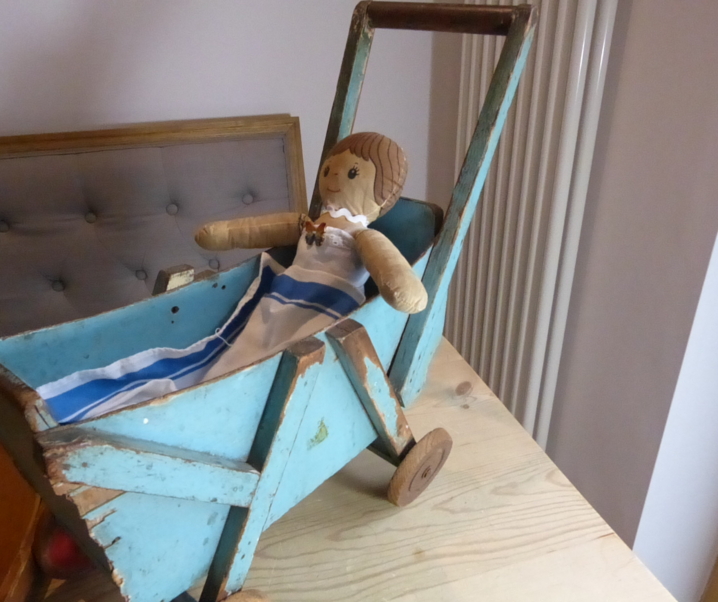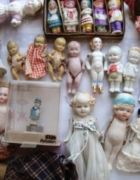When my nana moved into sheltered housing twenty years ago we had to re-home (skip) a wealth of vintage treasures including a tonne weight of antimacassars, porcelain dolls and a collection of Spanish tambourines with strange spaghetti-like string.

There was just one thing she would not relinquish. Her crocheted toilet roll-holder. This strange half-doll, half-bobble hat was a staple of the 60s and 70s childhood. There was a bit of ‘Hyacinth Bucket’ whiff around toilet roll dolls – they were for working class people who wanted to appear too posh to poo. By the 1980s, the toilet roll cover was considered so naff they only cropped up in Victoria Wood sketches.

I always imagined the ‘toilet roll holder’ doll was a 1960s thing until I chanced upon a ludicrously glamorous French boudoir ‘half-doll’ (a nice lady but completely legless) in a vintage shop in Derbyshire. The shop owner explained the voluminous skirt was empty because it has been designed to conceal everyday household objects like powder compacts. Which just goes to prove the difference between us and our Continental cousins. In 1920s, the Parisian lady would put satin half-dolls on their scent bottles whereas we plonked crocheted versions on loo rolls.

The story of these the original boudoir dolls begins, as all good tales should, in early part of the 20th Century Paris with a fashion designer called Paul Poiret. Known in America as the ‘king of fashion’, his shockingly revolutionary designs (designer speak for bonkers) enabled post war women to throw off their restrictive corsets in favour of loose fitting tunics, harem pants and sophisticated kimono-style coats. As the unofficial king of marketing – he’s also credited for getting grown-up women into decadently daring dolls.

Poiret was a clever self-publicist and collaborated with Mrs Lazareva, a Russian emigre with a celebrated doll’s workshop, to make bespoke dolls (in mini me outfits) as gifts for his wealthy clients. It wasn’t just great PR. Poiret wanted his ground-breaking designs to be showcased in pared-down, relaxed interiors, Draping a beautiful doll in a boudoir – on the bed or couch – was one way women could ‘carry their feeling for fashion into the furnishings of their homes.’

Women loved them. According to boudoir doll collector and maker Barbara Sutton-Smith; “After being introduced at the Paris fashion show in 1910, where Poiret’s models paraded cradled these long legged dolls with adult looking features…the Boudoir Doll became all the rage,” she says.

“They were posed on sofas and chairs, draped on beds and carried as mascots at balls, dances and social events.”
It became the norm for department stores and fashion houses to display these dolls; often wearing miniature versions of fashions in the window.
“They symbolised the new found freedoms women were experiencing for the first time,” says Lidy Baar, an antique aficionado who runs French Garden House.
“As the Edwardian era, with long layered clothing and high boots, gave way to the flapper era or jazz age, women were thrilled with their new modern “bobbed” hair styles, loose dresses and flat shoes. Dolls like this were sold in the Paris department store Au Bon Marche in the 1920’s.”
By 1924, according to Gary Chapman of the boudoir doll craze, the dolls became so mainstream the management of fashionable Le Perroquet night-spot gave each lady a beautifully dressed poupee (doll) as a souvenir.
“The dolls were called by various names like art, portrait, boudoir, art deco, flapper, vamp, bed, smoker, salon or parlour dolls,’ Gary Chapman explains.
‘These new dolls were different to what had been produced before as they were characterised by ornate, long limbs. long thin bodies, little hands and less ‘doll’ like, or ‘child’ like features or expressions; they had a stylised rather than a realistic appearance.”

These early dolls were undoubtedly status symbols. Many had silk or cloth faces which were beautifully painted and decorated with realistic hair be it human or camel. There were infinite varieties but the common denominator was a risque, often outrageous appearance marked by low-cut lace, silk stockings, red lips, extravagant eye-lashes, high heels…even cigarettes.

The fad reached its zenith when dolls as companions for adults were adopted by American movie stars like Clara Bow, Rudolph Valentino (who had 160 made) and, later, Joan Crawford.
“Soon Marlene Dietrich, Clara Bow and others were seen on the screen with their dolls and their fans were enchanted and copied them,” says Gary.
“At a dance at a leading hotel (in London) 30 young women were seen carrying their dolls.”

In the 1920s, companies like the fabulously named ‘Flapper Novelty Doll Company’ began to make boudoir dolls. Lenci boudoir dolls were especially prized. Madame Lenci, a doll-maker in Italy, produced the dolls from pressed felt. In various sizes and outfits (even uniforms), they caused a spat in Hollywood when co-stars Shirley Temple and Jane Withers argued over who got to keep their Lenci doll prop after the making of the movie ‘Bright Eyes’ (Shirley won but the pair remained friends).
Half-dolls were produced to look like a boudoir doll on top but the elaborate dresses were designed to conceal work-a-day items like make-up compacts, telephones and tea pots.

“Half dolls are just that – the upper half of a human figure, without legs,” says Denise Van Patten of website The Spruce.
“Half dolls were produced without legs so that they could be attached to something useful, very commonly, pin cushions, but also brooms, tea cosies, and numerous things that could grace a ladies dressing table, such as powder boxes.”

As with most crazes; the demand for boudoir doll – half or whole – dwindled when the market become flooded with cheaply made variations. Boudoir dolls continued to be made through the 30s and 40s but sales never regained the giddy heights of the flapper days.
There is still a demand for these beautiful dolls today. Value depends on condition, age, material, maker and outfit; expect to lose up to 50 per cent if the doll is not in its original clothing.

According to Lidy Baar of French Garden House; ‘Prices range from relatively inexpensive $100 (£75) or under…for the more common mass produced dolls to well over $3000 (£2266) for a rare doll.’

When it comes to the value of half-dolls, Denise Van Patten says quality counts. You can pick up crudely painted dolls from Japan from flea markets for £15-30. A good German doll may set you back £70-250.
“The more complex the mould used, generally, the more valuable the half doll,” she says.
“The most desirable have arms moulded completely away from the body…delicately and precisely painted half dolls are worth more than those with crude painting…more complex clothing (ruffles, hats, feathers) and more elaborate hairdos add to the value. Desirable accessories can include delicate grooming items, small animals and flowers and flower baskets.”

The best advice is to buy them because you love them; not to make your fortune. Antique expert Ian Crawford, of Bamfords in Derby, says prices for dolls in general have crashed since the heady days of the 1990s. The market is recovering slowly and the smart money has you checking the latest internet prices for similar items.

eBay the online auction site currently (November 2017) has a listings for Lenci dolls ranging from a hundred pounds to a couple of thousand.
As for the value of granny’s toilet roll concealer…there are listed on Ebay from £5 to an optimistic £12.

The future?
Social media is fuelling a renaissance in beautifully made artisan dolls. Lottie Girling, a doll maker and vintage collector from Hampshire, has even launched an account in the name of her homemade doll Anges.
Agnes goes to parties, enjoys the odd cocktail and suffers the inevitable hangover and her 450 plus followers are currently enjoying this sweet variation on an Instagram ‘story’.
Which means we’ve come full circle – dolls are back as a fashion accessory, companion and confidante. Our flapper-girl forerunners would heartily approve…but let’s just hope the toilet roll cover doll is consigned to history.
Read Gary Chapman’s definitive article on boudoir dolls on The Jazz Age Club












